|
Xtend
 Listen
Listen
 Jokes
Jokes
 Picture
Picture
 Evolution
Evolution
 Dictionary
Dictionary
 Internet
Internet
 Projects
Projects
 Home
Home
|
Xylophone
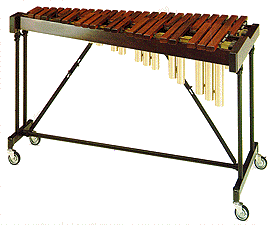  Tubular
Bells (chimes) Tubular
Bells (chimes)
Pitched instrumental chromatic percussion
These are percussions that can used to play an entire
tune rather than rhythms alone, effects and atmosphere, as other percussions:
The tubular bells also known as "chimes",
include a set of copper tubes hanging on a wooden
frame, in varying lengths in accordance to sound pitch. Hammering
produces sounds similar to that of church bells, as in the "1812"
overture by Tchaikovsky .
In the movement "the Grand gate of Kiev" in "Pictures
at the Exhibition" .
In the movement "the Grand gate of Kiev" in "Pictures
at the Exhibition" Mussorgski
Mussorgski integrates the tubular bells in a hypnotizing ostinato
integrates the tubular bells in a hypnotizing ostinato as against the orchestra, gradually strengthening in a spectacular
crescendo
as against the orchestra, gradually strengthening in a spectacular
crescendo towards the main theme.
towards the main theme.
The Xylophone is built as a wooden
keyboard (Xylus is Greek for wood) on which you hit with wood hammers.
Keys are placed on a band of rubber so their sound is not stopped. Underneath
each key, there is a resonance box that amplifies the sound's volume. Saint-Saëns used the Xylophone in "Danse Macabre",
and Rossini
used the Xylophone in "Danse Macabre",
and Rossini gave it a solo part in "The Magic Store".
gave it a solo part in "The Magic Store".
The Celesta - a kind of
a keyboard whose keys are attached to hammers beating
against steel plates. Tchaikovsky was the one who gave it its first symphonic part, in the dance of
the sugar nut queen, in "The Nutcracker"
was the one who gave it its first symphonic part, in the dance of
the sugar nut queen, in "The Nutcracker" . .
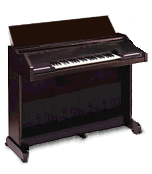 Celesta Celesta
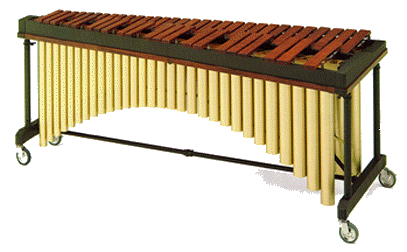 Marimba Marimba
The Marimba resembles the xylophone in shape.
The marimba was brought to America by African slaves
by African slaves ,
originally having hollow pumpkins under its keys.
In time, those were replaced by metal tubes as in the xylophone. In 1947,
Milhaud ,
originally having hollow pumpkins under its keys.
In time, those were replaced by metal tubes as in the xylophone. In 1947,
Milhaud wrote a concerto for marimba and vibraphone
and it has been extensively cultivated by composers since.
wrote a concerto for marimba and vibraphone
and it has been extensively cultivated by composers since.
Vibraphone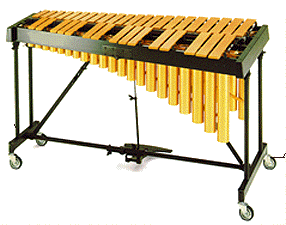 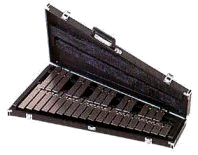 Glockenspiel Glockenspiel
Vibraphone is a xylophone
whose keys are made of metal instead of wood. At the end of each
tube there is a resonator, resonating to the key's sound, providing the
instrument with its typical floating sound. It is particularly popular
in jazz music, and the "Modern Jazz Quartet"
is known for having the vibraphone as its characteristic. Among the greatest
players of this instrument, we find the Jazz virtuoso player Lionel
Hampton.
music, and the "Modern Jazz Quartet"
is known for having the vibraphone as its characteristic. Among the greatest
players of this instrument, we find the Jazz virtuoso player Lionel
Hampton.
The glockenspiel is a metal
keyboard that makes sounds of tiny bells. In his many works for
children, Orff used many kinds of percussion, among which is the glockenspiel in
his "Carrol of the Bells". Kodály
used many kinds of percussion, among which is the glockenspiel in
his "Carrol of the Bells". Kodály used the glockenspiel in the "Háry János"
suite.
used the glockenspiel in the "Háry János"
suite.

 Ancient Tubular Bells
Ancient Tubular Bells
|
|
Composers

Tchaikovsky

Rimsky-Korsakov

Mussorgski

Saint-Saëns

Rossini

Orff
|